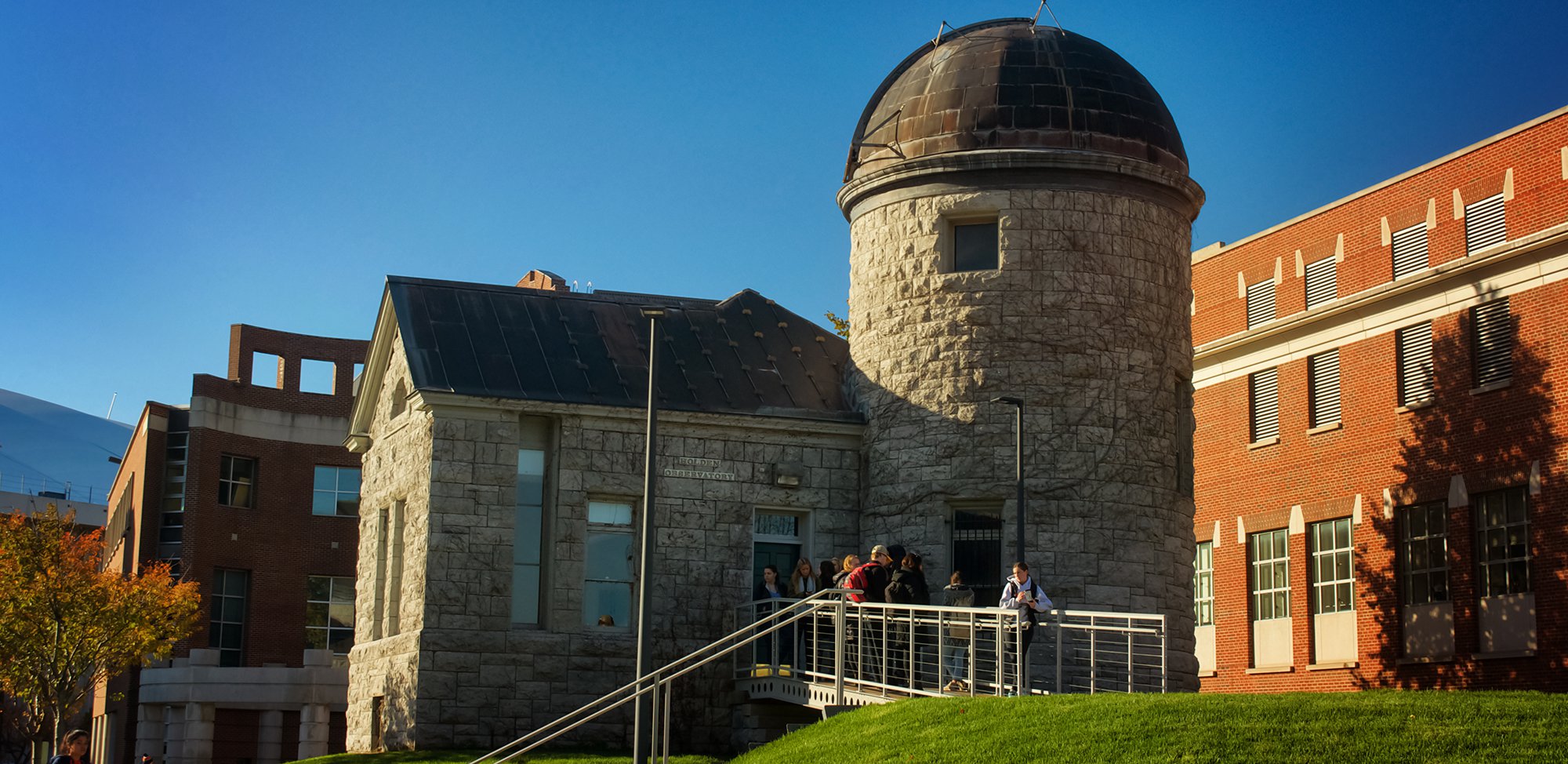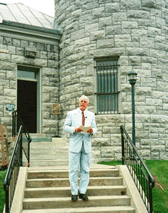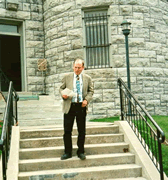Holden Rededication

Remarks at Holden Rededication
Holden Rededication September 3, 1998 Michael Flusche, Associate Vice Chancellor for Academic Affairs
Almost 111 years ago, on November 18, 1887, classes were suspended at this fledgling university so students and faculty could attend the dedication of the Charles Demarest Holden Observatory. The main speaker on that occasion was Dr. Simon Newcomb of Washington DC; his talk was entitled "The Place of Astronomy in the Sciences." Also, undergraduate Henry Sibley, class of 1889, wrote a poem to celebrate the dedication:
Hurrah, hurrah for Syracuse!
Ye winds repeat the story.
Sing in thy loftiest strains, my muse,
Our new Observatory.
This was a major event, worthy of one's best poetic efforts. Holden Observatory was the second building on the new college campus and the first building in a wave of new buildings.

Two years later (1889) Crouse College was built, followed by the University Library (now Tolley Administration Building). In 1890 the campus consisted of the Hall of Languages, Holden Observatory, Crouse College and the Library (Tolley). All of the original buildings, with the exception of the Hall of Languages, were designed by Archimedes Russell, one of central New York's most successful architects. Mr. Russell also designed 2 of Cornell University's first four buildings, the County Court House on Montgomery Street in Syracuse plus others notable buildings in the city.
The observatory was a gift of Erastus Holden, a Syracuse Coal Dealer and first Vice President of the Syracuse University Board of Trustees, in memory of his son Charles. Charles Holden was a freshman in the class of 1877, co-founder of the SU crew team, and star basketball player, who died of a heart ailment before he graduated.
Holden Observatory was cleverly designed to house a variety of astronomical instruments plus research and teaching facilities in the first floor classroom. It was designed and located to serve students. From its early days, students and the public were invited to view the heavens from its telescope. Perhaps its most intensive use was in 1939, when Mars passed close to Earth. According to newspaper accounts of the time, lines stretched out of the Observatory toward Archbold Stadium and the public waited until 3:00 a.m. to view the red planet.
After World War II use of the telescope seems to have fallen off. From 1947 through the 1950's, the basement of Holden was used for storage of radioactive isotopes - University scientists were experimenting with radioactivity in a variety of ways, including the preservation of food by killing bacteria.
Throughout its life this gem of a building has been threatened by progress.
- In 1908 the campus plan for the growing University called for relocation of the observatory to Mt. Olympus. Obviously this did not happen.
- In 1964 a newspaper article by Dick Case in the Herald-American had the headline: Progress Dooms SU's Observatory. Plans were being made for a new Physics Building which would include a new observatory, or perhaps a new observatory would be built in the country. Case quotes the University's proposal to the National Science Foundation: "Steele Hall and the observatory are obsolete in the space age." Fortunately, the building was spared.
- In 1980, the observatory was registered as a National Landmark to afford it protection and to call attention to its special value. The telescope was used much less, and the building was put to a variety of uses, housing in succession, the University Information Center, the Soling Program, and the Office of the University Senate Recorder.
- In 1991, Holden Observatory was again threatened by progress - Eggers Hall was to be built. That summer, the observatory was moved 190 feet to the west of its original location under the direction of John Dexheimer, a farmer from Chenango County who is a specialist in moving buildings. In July 1991, the building, all 320 tons of it, with limestone walls (2 feet thick in spots) went cruising across 190 feet of campus at .0042 miles per hour or 4 inches per minute.
Now, with repaired walls and roof, refurbished interior, and refractor telescope restored, we are rededicating the "new" Holden Observatory. All involved deserve our thanks and appreciation:
- Virginia Denton and Walt Banziger in Design and Construction;
- Workers and Craftsmen in Physical Plant;
- Peter Saulson and Eric Schiff and their colleagues in the Physics Department;
- And especially Andri Gretarsson and Lou Buda in the Physics Department, who restored the telescope.
We thank all these people for preserving and refurbishing this monument, this landmark. The Observatory is a monument to the founding generation of the University who had the vision to invest in an observatory when faced with many severe financial needs. We also thank all donors to the University, such as Erastus Holden, and to the generations of scientists and scholars whose instruments and techniques have become obsolete, because of their collective scientific progress. The telescope is now a beautiful working instrument, permitting all of us to visually visit neighboring planets and stars and become more aware of our place in the cosmos. I certainly intend to visit it and I invite you to do so as well.
I can do no better than close with the lyric poem, slightly revised, presented 111 years ago by Henry Sibley:
Hurrah, hurrah for Syracuse!
Ye winds repeat the story.
Sing in thy loftiest strains, my muse,
Our (re)new(ed) Observatory.
Prof Peter R. Saulson, Dept. of Physics

Astronomy is about time- and about eternity. The rhythm of the days and months, the cycle of the seasons, all have their origins in the Earth's relation to the larger Universe. But no one can look at a starry night sky without also pondering questions far beyond those of the rhythms of our daily life on Earth.
This observatory was built as an act of memory, and an act of hope. Rededication is also about memory and about hope. We are here to remember the efforts of our predecessors, to commemorate their hopes for the future, and to act on our own hopes for our future.
Last week I went to Bird Library to find some books that would help me to picture what thoughts about astronomy would have motivated Chancellor Sims to seek an observatory as only the second building at Syracuse University, what thoughts might have motivated the Holden family to choose an observatory as a memorial for their son Charles, and what might have motivated America's leading astronomer, Simon Newcomb, to make the long journey from Baltimore to speak at its dedication.
In the stacks of neglected books in the basement, I found an astronomy textbook from 1887, written by two eminent astronomers: Simon Newcomb himself, and another Holden, Edward Singleton, who had just founded Lick Observatory in California. Lick was the first of the great mountain observatories of the American West that did so much to advance astronomy as the 19' century became the 20'. (Its founder, Edward S. Holden was a sixth cousin of our benefactor, Erastus F. Holden.)
Two things about the book struck me right away. The first was the complete absence of photographs of the sky. This makes sense - it was only in 1880 that the very first photograph was made through a telescope. The second odd thing was how little was said (because how little was known) about the wider Universe beyond the Solar System. Mostly, the stars served as a backdrop for the story of our little neighborhood.
Reading more carefully revealed a more subtle difference - a different attitude toward time than one finds in today's textbooks. Part of that comes from the much greater emphasis placed on the many rhythms of the sky: the day, the month, the year, and the motions of the planets, asteroids, and comets.
That emphasis on time was also exemplified by Holden Observatory itself. In addition to the Alvan Clark telescope whose refurbishment we celebrate with today's ceremony, there were other instruments as well. The east wing of the building held a transit, used for observing the time of passage of a star across the meridian (the North-South line through the sky.) The roof used to slide back to give the transit a view of the whole meridian, and you can still see the narrow vertical windows in the north and south walls that formed part of that slit. The transit itself was thought to be lost, but was discovered just two days ago by Lou Buda in a storeroom in the basement of the Physics Building.
A transit would be useless without a good clock to mark the times; we read in the records of the observatory dedication that it was equipped with two good clocks, and that a third was soon added.
When you visit the telescope upstairs in the dome, you will see another hallowed form of time-keeping. The drive that keeps the telescope pointed at a star as the Earth turns is an all-mechanical affair, driven by a weight on a cable. Its speed is regulated by a flyball governor, a device invented by James Watt a century earlier. Its peaceful whirring is the closest you will hear to the sound of the Earth spinning on its axis.
An old-fashioned sense of cosmic time scales is also present in the 1887 book of Newcomb and Holden. The Sun's source of energy was not understood at all; the book reckons that the Sun only has been able to shine at its present rate for a mere 18,000,000 years. I'm proud to say that an S.U. student wrote neatly in the margin, "How does this agree with Geology?" Indeed it didn't, and the reconciliation of astronomy with geology was a part of the great scientific discoveries of the early part of the 20' century. Of course, Newcomb and Holden hadn't an inkling of the expansion of the Universe that has led to our present notions of a beginning of the entire Universe about 15 billion years ago.
A modem eye will note with surprise the authors' comfort with the glacial pace of change in our view of the Universe. The one great discovery they report about the Universe of stars and beyond was made by William Herschel in 1785, a full century previously. Newcomb wrote elsewhere, "We may fairly anticipate that each successive generation of astronomers, through coming centuries, will obtain a little more light on the subject." What a contrast to our present-day expectations of a new scientific revolution every decade.
Yet, in spite of this apparent complacency, everyone present near this spot in 1887 was engaged in an act of hope for the future. The founding of the Holden Observatory, like E.S. Holden's founding of the Lick Observatory, was part of a great movement, whose object was to build our understanding of the world. That their work has bome such rich fruit is the ultimate cause for us to honor their memory today, and to pledge to carry on in their spirit.
